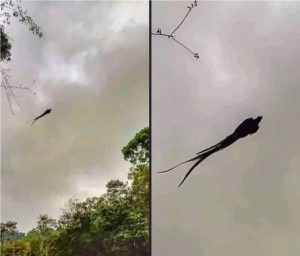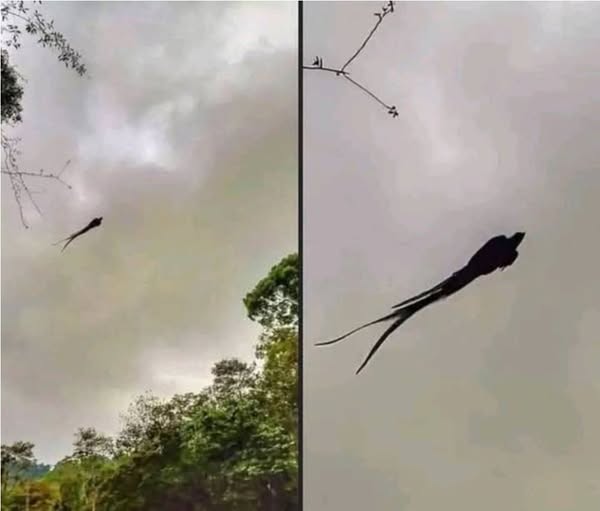The Quetzal: A Magnificent Sign of Natural Beauty and Cultural Legacy
Many people consider the quetzal, a bird endemic to Mexico and Central America, to be among the most beautiful. Beyond its aesthetic appeal, it has profound cultural and historical significance because it was closely linked to the ancient god Kukulkan.
This revered bird was known to the Mayans as Q’uk’umatz, or “the feathered serpent.” They left behind images of the quetzal in flight, such as the ones lately taken from the ideal vantage point along the Corozal border in Chiapas, along with its moniker. These stunning pictures captivated people all over the world as they swiftly went viral on social media.

A Mysterious Flight: Dementor or Quetzal?
A remarkable silhouette emerged in the sky above a village in Frontera Corozal, Chiapas, on April 12. It looked like a Dementor from Harry Potter, but it was actually the captivating flight of a quetzal, captured by a local witness at the perfect moment. The picture quickly went viral, bringing attention to this endangered species’ predicament.
Many viewers sarcastically envisioned a hint of wizardry seeping into the real world due to the unique lighting and viewpoint. Some people even theorized that the bird was a ghost that was floating around looking for memories. It is noteworthy that a month prior, a quetzal had been moved from the Cuauhtémoc district of Mexico City to the Miguel Álvarez del Toro Zoo.
The Quetzal: The Living Jewel of Nature
This monogamous bird lives in tropical and subtropical woodlands and eats frogs, mollusks, insects, lizards, and aguacatillos. But it has many predators, including hawks, eagles, owls, squirrels, and emerald toucanets. Unfortunately, humans continue to pose the biggest threat to quetzals because they catch them for the pet trade despite knowing that they cannot thrive in captivity. When confined, they will cease to eat and eventually die.
Fortunately, a few quetzals have been successfully returned to the wild after being saved from captivity. Its small yellow beak, gentle crest on top of its head, and serene, black eyes are what make this bird so endearing. Males are particularly impressive, with iridescent plumage that shimmers in shades of orange, yellow, blue, and emerald green elsewhere and has vivid reds on the belly. One characteristic that distinguishes the species’ sexual dimorphism is their long, flowing tail feathers, which can reach a length of one meter.
In contrast, females lack the ostentatious tail feathers and have more muted green and gray colors. A quetzal’s flight is a once-in-a-lifetime experience, but its survival is increasingly threatened by the dwindling cloud forests on which it depends.
An Esteemed Spirit of the Heavens
Quetzals were considered sacred birds in ancient Mesoamerican societies. Even though they are endangered, several individuals are still seen in the wild today. The Mayans associated the quetzal with Kukulkán, whereas the Mexicas associated it with the god Quetzalcóatl, according to Mauricio Ruíz Velasco of UNAM’s Institute of Philological Research.
These gods represented the sky, the sun, and, appropriately, liberty. Because it cannot thrive in captivity, the quetzal is a literal embodiment of this freedom. Its incapacity to survive in captivity emphasizes its spiritual value and heightens the impact of the sight of a quetzal flying through the mist-covered trees.
